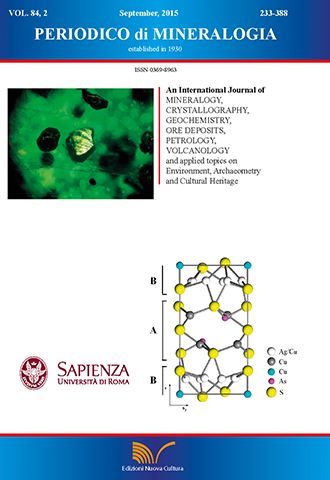How much copper can the pearceite structure sustain? The case of cupropearceite from Tsumeb, Namibia
DOI:
https://doi.org/10.2451/2015PM0017Keywords:
sulfosalts, crystal structure, chemical composition, copper, fast ionic conductor, TsumebAbstract
The intriguing recovery of an extremely Cu-rich cupropearceite crystal (Cu = 7.62 a.p.f.u.) from Tsumeb, Namibia, allowed us to study the effect of the entry of Cu in the positions usually occupied by Ag in the B module layer in the structure of the minerals belonging to the pearceite-polybasite group. Electron microprobe analysis yields the formula [Cu6(As1.89Fe0.01)Σ=1.90S7.05][(Ag8.36Cu0.62)Σ=8.98CuS4.06]. Lattice parameters are: a = 7.144(1), c = 11.745(2) Å, V = 519.1(2) Å3. The structure was refined in the space group Pm1 up to R = 0.0278 using 489 observed reflections [2σ(I) level]. The entry of these elevated amounts of Cu in the structure does not induce a structural change and shows that pearceite is able to accommodate higher contents of Cu than previously thought. This allows hypothesis of the existence of an ideal [Cu6As2S7][Cu9CuS4] end member in nature. Such a proposed Ag-free mineral would show the highest structural disorder so far observed for a pearceite structure and, consequently, the highest ionic conductivity and could find applications in silver photography as sensitizer or in optics and microelectronics as rewritable storage medium.


